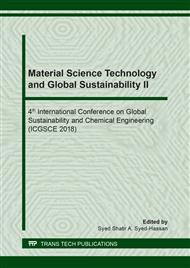[1]
A. Pirkarami and M.E. Olya, Removal of dye from industrial wastewater with an emphasis on improving economic efficiency and degradation mechanism, Journal of Saudi Chemical Society 21 (2017) S179-S186.
DOI: 10.1016/j.jscs.2013.12.008
Google Scholar
[2]
J. Polak, A. J. Wilkolazka, A. S. Ciesielska, K. Wlizlo, M. Kopycinska , J. S. Ledakowicz, J. L. Olczyk, Toxicity and dyeing properties of dyes obtained through laccase-mediated synthesis. Journal of Cleaner Production 112(5) (2016) p.4265–4272.
DOI: 10.1016/j.jclepro.2015.07.044
Google Scholar
[3]
A. Gnanaprakasam, A., V.M. Sivakumar and M. Thirumarimurugan, Influencing Parameters in the Photocatalytic Degradation of Organic Effluent via Nanometal Oxide Catalyst: A Review. Indian Journal of Materials Science (2015) pp.1-16.
DOI: 10.1155/2015/601827
Google Scholar
[4]
Ö. Kerkez-Kuyumcu, E. Kibar, K. Dayıoğlu, F. Gedik, A.N. Akın, and Ş. Özkara-Aydınoğlu, A comparative study for removal of different dyes over M/TiO2 (M=Cu, Ni, Co, Fe, Mn and Cr) photocatalysts under visible light irradiation. Journal of Photochemistry and Photobiology A: Chemistry 311 (2015) pp.176-185.
DOI: 10.1016/j.jphotochem.2015.05.037
Google Scholar
[5]
S.H.S. Chan, T.Y. Wu, J. C. Juan and C. Y. Teh, Recent developments of metal oxide semiconductors as photocatalysts in advanced oxidation processes (AOPs) for treatment of dye waste-water, Journal of Chemical Technology & Biotechnology 86 (2011) p.1130–1158.
DOI: 10.1002/jctb.2636
Google Scholar
[6]
Z. Liu and C. Zhou, Improved photocatalytic activity of nano CuO-incorporated TiO2 granules prepared by spray drying. Progress in Natural Science: Materials International 25(4) (2015) pp.334-341.
DOI: 10.1016/j.pnsc.2015.07.005
Google Scholar
[7]
S. Bagheri, N. Muhd Julkapli and S. Bee Abd Hamid, Titanium dioxide as a catalyst support in heterogeneous catalysis. The Scientific World Journal (2014).
DOI: 10.1155/2014/727496
Google Scholar
[8]
J. Araña, A. Peña Alonso, J.M. Doña Rodríguez, J.A. Herrera Melián, O. González Díaz, J. Pérez Peña, Comparative Study Of Mtbe Photocatalytic Degradation With TiO2 And Cu-TiO2, Applied Catalysis B: Environmental 78(3–4) (2008) pp.355-363.
DOI: 10.1016/j.apcatb.2007.09.023
Google Scholar
[9]
S. M. Reda, M. Khairy and M. A. Mousa. Photocatalytic activity of nitrogen and copper doped TiO2 nanoparticles prepared by microwave-assisted sol-gel process, Arabian Journal of Chemistry (2017) In press.
DOI: 10.1016/j.arabjc.2017.02.002
Google Scholar
[10]
B. Khodadadi, M. Sabeti, S. Moradi, S., P. A. Azar and S. R. Farshid, Synthesis of Cu-TiO2 nanocomposite and investigation of the effectiveness of PEG, Pectin, and CMC as additives, Journal of Applied Chemical Research 20(1) (2012) pp.36-44.
Google Scholar
[11]
U. G. Akpan and B.H. Hameed, Parameters affecting the photocatalytic degradation of dyes using TiO2-based photocatalysts: a review. J Hazard Mater. 170(2-3) (2009) pp.520-9.
DOI: 10.1016/j.jhazmat.2009.05.039
Google Scholar
[12]
P. Dharmarajan, A. Sabastiyan, M. Y. Suvaikin, S. Titus, and C. Muthukumar, Photocatalytic degradation of reactive dyes in effluents employing copper doped titanium dioxide nanocrystals and direct sunlight. Chem. Sci. Trans 2(4) (2013) pp.1450-1458.
DOI: 10.7598/cst2013.575
Google Scholar
[13]
M. Lei, N. Wang, L. Zhu, Q. Zhou, G. Nie, and H. Tang, Photocatalytic reductive degradation of polybrominated diphenyl ethers on CuO/TiO2 nanocomposites: A mechanism based on the switching of photocatalytic reduction potential being controlled by the valence state of copper. Applied Catalysis B: Environmental 182 (2016) pp.414-423.
DOI: 10.1016/j.apcatb.2015.09.031
Google Scholar
[14]
J. Ma, H. He, and F. Liu, Effect of Fe on the photocatalytic removal of NOx over visible light responsive Fe/TiO2 catalysts. Applied Catalysis B: Environmental. 179 (2015) pp.21-28.
DOI: 10.1016/j.apcatb.2015.05.003
Google Scholar
[15]
I. Ganesh, P. P. Kumar, I. Annapoorna, J.M. Sumliner, M. Ramakrishna, N. Y. Hebalkar, G. Padmanabham, and G. Sundararajan, Preparation and characterization of Cu-doped TiO2 materials for electrochemical, photoelectrochemical, and photocatalytic applications. Applied Surface Science, 293 (2014) pp.229-247.
DOI: 10.1016/j.apsusc.2013.12.140
Google Scholar
[16]
W. Zhang, L. Zou and L. Wang, Photocatalytic TiO2/adsorbent nanocomposites prepared via wet chemical impregnation for wastewater treatment: A review. Applied Catalysis A: General. 371(1-2) (2009).
DOI: 10.1016/j.apcata.2009.09.038
Google Scholar
[17]
Y. Li, W. N. Wang, Z. Zhan, M. H. Woo, C.Y. Wu and P. Biswas, Photocatalytic reduction of CO2 with H2O on mesoporous silica supported Cu/TiO2 catalysts. Applied Catalysis B: Environmental, 100(1-2) (2010) pp.386-392.
DOI: 10.1016/j.apcatb.2010.08.015
Google Scholar
[18]
S. Sakthivel, M.V. Shankar, M. Palanichamy, B. Arabindoo, D.W. Bahnemann, and V. Murugesan, Enhancement of photocatalytic activity by metal deposition: characterisation and photonic efficiency of Pt, Au and Pd deposited on TiO2 catalyst. Water Res, (13) (2004) pp.3001-8.
DOI: 10.1016/j.watres.2004.04.046
Google Scholar
[19]
M. Reli, K. Koci, V. Matejka, P. Kovar, and L. Obalova, Effect of calcination temperatureand calcination time on the Kaolinite/TiO2 composite for photocatalytic reduction of CO2. GeoScience Engineering 8(4) (2012) pp.10-22.
DOI: 10.2478/v10205-011-0022-2
Google Scholar
[20]
S. Kruanetr, N. Tan-arsa, and R. Wanchanthuek, The study of Methylene Blue removal by using mixed TiO2 as a catalyst under solar light irradiation. Journal of Scientific and Research Publication 3(6) (2003).
Google Scholar


